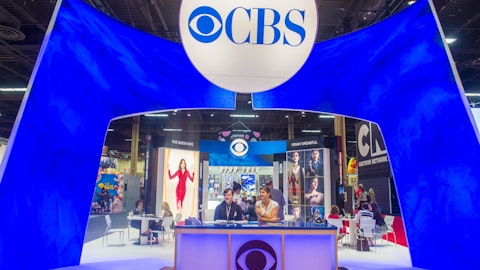Sinclair Broadcast Group, Inc. (NASDAQ:SBGI) Q4 2023 Earnings Call Transcript February 28, 2024
Sinclair Broadcast Group, Inc. misses on earnings expectations. Reported EPS is $-5.35 EPS, expectations were $0.46. SBGI isn’t one of the 30 most popular stocks among hedge funds at the end of the third quarter (see the details here).
Operator: Greetings. Welcome to the Sinclair Fourth Quarter 2023 Earnings Conference Call. At this time, all participants are in a listen-only mode. A question-and-answer session will follow the formal presentation. [Operator Instructions] Please note, this conference is being recorded. I will now turn the conference over to your host, Chris King, Vice President of Investor Relations. You may begin.
Chris King: Thank you. Good afternoon everyone and thank you for joining Sinclair’s fourth quarter 2023 earnings conference call. Joining me on the call today are Chris Ripley, our President and Chief Executive Officer; Lucy Rutishauser, our Executive Vice President and Chief Financial Officer; and Rob Weisbord, our Chief Operating Officer and President of Local Media. Before we begin, I want to remind everyone that slides and supplemental information for today’s earnings call are available on our website, sbgi.net, on the Investor Information page and on the earnings webcast page. Certain matters discussed on this call may include forward-looking statements regarding, among other things, future operating results. Such statements are subject to a number of risks and uncertainties.
Actual results in the future could differ from those described in the forward-looking statements as a result of various important factors. Such factors have been set forth in the company’s most recent reports as filed with the SEC and included in our fourth quarter earnings release. The company undertakes no obligation to update these forward-looking statements. The company uses its website as a key source of company information, which can be accessed at www.sbgi.net. In accordance with Regulation FD, this call is being made available to the public. A webcast replay will be available on our website and will remain available until our next quarterly earnings release. Included on the call will be a discussion of non-GAAP financial measures, specifically adjusted EBITDA, adjusted free cash flow, and leverage.
The company considers adjusted EBITDA to be an indicator of the company’s operating performance and the ability to service its debt. The company also believes that adjusted EBITDA is frequently used by industry analysts, investors, and lenders as a measure of valuation and the ability to service debt. The company also discloses segment adjusted EBITDA as an indicator of the operating performance of its segments in accordance with ASC 280 segment reporting. The company considers adjusted free cash flow to be an indicator of the company’s operating performance. The company also believes the free cash flow is a commonly used measure evaluation for companies in the local media industry. In addition, this measure is frequently used by industry analysts, investors, and lenders as a measure of valuation for local media companies.
These measures are not formulated in accordance with GAAP, are not meant to replace GAAP measurements, and may differ from other companies’ uses or formulations. The company does not provide reconciliations on a forward-looking basis. Further discussions and reconciliations of the company’s non-GAAP financial measures to comparable GAAP financial measures can be found on our website, www.sbgi.net. Any discussion of pro forma numbers as compared to 2022 will exclude Diamond Sports, which was deconsolidated March 1st, 2022, and any business sold since the beginning of 2022. For actual results, including the periods that Diamond was consolidated, please refer to this afternoon’s earnings release. Let me now turn the call over to Chris Ripley.
Christopher Ripley: Good afternoon everyone and thank you for joining us. I’ll start on Slide 4 by introducing an overview of our fourth quarter financial results. As you can see, Sinclair delivered solid fourth quarter results that met our guidance expectations in our Local Media segment, while Tennis Channel exceeded expectations across the board. As a result, we were comfortably within the consolidated guidance ranges for total revenues, adjusted EBITDA, and adjusted free cash flow. Turning to Slide 5. I wanted to highlight our strong commitment to our stakeholders through our return of free cash flow generation during the past year. In 2023, we paid approximately $65 million in quarterly dividends. During the year and up through January, we purchased $91 million of face value of debt at an average discount to par of 19%.
This amount excludes our scheduled amortization payments, which allowed us to retire an additional $28 million of debt in 2023. In early 2023, we also repurchased nearly 9 million shares of our common stock. Our commitment to maximizing value for all of our stakeholders remains a top priority for the company. Turning to Slide 6. As we have stated in the past, we remain dedicated to our traditional Local Media business with the realization that the industry needs to transform due to subscriber churn and regulatory constraints. With that being said, we believe Sinclair as well as the broader industry has multiple growth drivers as we head into a presidential election year. First, we expect to see record-breaking political advertising revenues in 2024, which equates to exceeding 2020’s political revenues of $350 million, which excludes the impact of the Georgia runoff.
We saw 2023 political revenues trend above both 2021 and 2019 levels. and we expect the strong growth of issue-oriented political advertising in what appears to be several close Senate and House races in our footprint to accelerate this growth significantly as we get closer to this year’s election. Given the lack of hypercompetitive primaries, we do expect political advertising spend to be more heavily weighted to the third and fourth quarters as we anticipate most of the spend at the presidential level will be focused on the general election. Second, our focus on high-demand differentiated local news and sports content as well as syndicated programming continues to drive strong and loyal viewership with 43% of viewer impressions across our station portfolio driven by non-network content.
In addition, with nearly all of our big four traditional subscribers renewing by the end of 2024, we expect a mid-single-digit net retrans two-year CAGR growth rate from 2023 through 2025. NextGen Broadcast is becoming a reality as well. We now have 30 coverage in half of our 86 markets and over 75% of the U.S. as of January this year. Over 10 million NextGen TVs have been sold thus far, and we are excited about NextGen’s future potential. And while the regulatory environment is far from positive overall for broadcasters, particularly from a relative perspective to our big tech and big media competitors, we are cautiously optimistic regarding long-term changes for a couple of industry items, including guidelines regarding the sunset of the industry’s 1.0 [ph] spectrum as NextGen 3.0 spectrum is used more widely and the ability to negotiate directly with virtual MVPDs. In the interim, our focus on sales excellence drove over 3% core advertising growth in the fourth quarter, the highest growth rate in our publicly-traded peer group.
Turning to Slide 7. In mid-January, we announced a global settlement with the Diamond Sports Group that eliminates all outstanding litigation claims between the two companies. Per the settlement that the court approved earlier this week, pending the finalization of certain final documents, Sinclair will pay a total of $495 million with the first $50 million expected to be due this week, which is being paid by ventures and the rest is expected to be paid as determined within 60 days. In exchange, Diamond has agreed to drop the $1.5 billion litigation against Sinclair and others. We estimate the gross amount of $495 million results in a net cost of approximately $250 million to $325 million when including tax benefits associated with the settlement, increased management fees from Diamond, and other assets.
Importantly, we believe the settlement and the approval of Diamond’s reorganization plan helps safeguard the future of Diamond and thus, the broader regional sports network environment. We believe the continued existence of local sports in the pay TV bundle, including being via the RSNs will be a key asset in driving rate re-bundling and the Pay TV bundle going forward. In light of this development, as well as the Disney Charter carriage agreement that we discussed during our third quarter call, it is our view that the relative value of the Pay TV bundle as compared to à la carte D2C offerings remain strong and is, in fact, improving as the environment shifts — continues to shift in favor of the Pay TV bundle. We also believe that the recent Fox Disney, Warner Bros.
Discovery Sports bundle announcement will not negatively impact us as we expect our Fox and ABC stations to be carried on the streaming platform, which would allow us to receive compensation. We look forward to continue discussions with our networks and distribution partners as to how we can add content and other value to consumers and attract more subscribers back to the value of the bundle. And speaking of value, this year’s Super Bowl highlighted the value of broadcast television in the media ecosystem. With Super Bowl 58 setting a viewership record in January of this year with 123.7 million viewers, making it the most watched telecast in U.S. history with an estimated 112 million viewers on linear CBS alone, which represents the highest single audience on any one network in U.S. history.
Our 30 CBS affiliate stations played a significant role in delivering the game and help to contribute to that record-breaking audience underscoring the importance of broadcast television. Now, let me turn it over to Rob to discuss our Local Media strategy.
Robert Weisbord: Thanks Chris. Turning to Slide 8, I wanted to begin by touching on the broad advertising environment and our industry-leading core advertising growth. Pro forma advertising, excluding political, was up approximately 2.5% year-over-year during the fourth quarter in our Local Media business segment, while on a consolidated basis, we delivered growth of 3.2% in the fourth quarter. Before I jump into our category breakdown, I wanted to follow up on Chris’ highlight on the importance of broadcast to the media landscape in regards to the Super Bowl, not only was this year the highest was broadcast in history, we also grew our ad revenue 43% over last time that CBS hosted the Super Bowl showcasing the power of live sports.
Now, into categories. Services continue to be a top performer of 8% year-over-year in the quarter, while automotive remained strong, up 5% and retail up 9%, driven by home products and nutrition. Heading into 2024, retail, services, and legal remained strong, while medical and drug categories as well as food are slightly down during the first two months of the year. In addition, we expect modest pressures in the auto category during the first quarter due to less premium sports programming in the year ago period. On Slide 9, I wanted to provide a quick update on political ad spend. As we look forward to 2024, we booked $24 million in political advertising in the fourth quarter of 2023, just shy of our quarterly guidance, but hitting a nonelection year record of $44 million for the year.
The modest $1 million miss of our guidance range was largely due to timing of spend and the early withdrawal of several Republican candidates from the Iowa caucus. While we anticipate political revenues will be back-end loaded this year, we continue to see strong trends from PAC and super PAC fundraising and heavy spend forecasted to continue for issue-based advertising. These items lead us to continue to expect a record-breaking election year for us in 2024. Turning to Slide 10. We have signed two distribution agreements in recent months. This includes multiyear deals with both Verizon and NCTC. Nearly all of the remaining traditional Big 4 network subscribers are on agreements that expire between now and the end of 2024. In addition, we announced an extended affiliation partnership with Fox in all 41 of our Fox markets covering 19 million households.

This includes the early renewal of 17 markets. We now have only one big 4fournetwork affiliation that expires before the back half of 2026. With our negotiation schedule in mind, we expect a mid-single-digit two-year CAGR for net re-trans from 2023 through 2025. As Chris highlighted earlier, we continue to see positive industry trends regarding the long-term stability of net retransmission revenues. Now, let me turn the call back over to Chris to provide an update on our NextGen broadcast plan as well as our Ventures segment.
Christopher Ripley: Thanks Rob. On Slide 11, I wanted to provide a couple of quick updates regarding NextGen broadcast technology, which has now been deployed in half of our markets, and nationwide coverage is over 75% as the industry continues to improve NextGen reach. TCL has joined Sony, Samsung, and HiSense’s TV manufacturers with models that have built in NextGen TV capabilities. In fact, Sony is including NextGen availability at every set it sells in the U.S. today. We continue to play a leading role in accelerating the adoption of the DDoS model and the continued transformation of local broadcast capabilities not only in the U.S. but globally. As seen on Slide 12, the Tennis Channel recorded another strong quarter with $54 million in total revenue and $22 million in adjusted EBITDA, both well in excess of our quarterly guidance.
For the full year, Tennis Channel delivered $228 million in revenues and $72 million in adjusted EBITDA or $80 million when excluding Tennis initiative losses. We expect continued strong growth metrics from Tennis Channel. Moving to Slide 13. The average number of households watching Tennis Channel in the fourth quarter grew by 36% year-over-year, while total viewers grew by 25% and social media impressions grew by 58% year-over-year. Once again, Tennis Channel ratings growth outpaced all other English language sports networks in the world. The TC Plus streaming platform increased monthly subscribers by 7% year-over-year, while authenticated viewing for MVPD customers grew by 3%. The T2 fast channel grew by 36% year-over-year as its exclusive Tennis content continues to drive strong growth across multiple delivery platforms.
In addition, Tennis Channel will launch a direct-to-consumer offering in 2024, which will provide a new leg of growth. We also believe Pickleball will drive even stronger growth metrics for Tennis Channel in the coming quarters. Internationally, Tennis Channel continues to grow its portfolio of rights, recently acquiring the WTA rights for both EMEA and Spain. Furthermore, we see multi-language versioning using artificial intelligence as a way to enhance both revenue streams in international markets as well as expense reductions. We see many opportunities ahead for Tennis Channel. I want to provide a brief update on our ventures investment portfolio on Slide 14, which we now excludes consolidated assets Tennis Channel and Compulse as well as other consolidated holdings.
As of December 31st, the minority investment portfolio’s market value was $1.2 billion, which includes a cash position of $343 million. Of note, during the quarter, the company made additional cash capital contributions of approximately $28 million in minority investments. For the full year, we contributed $72 million in minority investments and received $45 million in distributions. As we’ve stated in the past, our goal over time is to transition a significant amount of these minority investments into other majority-owned investments that we can — that we expect to have long-term growth potential and consolidation opportunities as well as providing greater visibility into the performance of Ventures assets. We will continue to update our investors on a regular basis as we transform the investment portfolio.
Before I turn the call over to Lucy to discuss the financial results, I wanted to highlight our awards and charitable endeavors over the past year. Sinclair won 276 broadcast awards in 2023, including 16 National awards, one of which was the prestigious National Edward R. Murrow Award for our Seattle Station KOMO. On the charitable front, we partnered with more than 400 non-profit and civic organizations across the country in an effort to be supportive and engaged members of the communities in which we serve. We raised nearly $30 million and collected more than 2.3 million pounds of food, 3,700 pints of blood, over 642,000 diapers, and almost 100,000 toys. We also provided over $300,000 in tuition assistance over the past 10 years through our annual diversity scholarship and held our first company-wide Day of Service in April, which saw almost 1,700 employees volunteering their time to provide over 4,800 hours of service during that single day alone.
I want to take the opportunity to thank our employees for their charitable efforts and look forward to another successful day of service this year. Now, let me turn it over to Lucy to provide additional details on our financial results for the quarter.
Lucy Rutishauser: Thank you, Chris and good afternoon everyone. Beginning on Slide 16, on a consolidated basis, we delivered media revenues during the fourth quarter that met our guidance range as core advertising met and distribution revenues exceeded our guidance. As compared to last year, which was a midterm election year, consolidated media revenues decreased to $821 million during the quarter, primarily on the lower political revenues in a non-election year offset in part by increases in distribution revenue and core advertising. On Slide 17, consolidated adjusted EBITDA also was within our guidance range, with OpEx costs coming in as expected. As compared to last year on a pro forma basis, consolidated adjusted EBITDA in the quarter decreased from the 2022 period, as expected, with media revenues contributing nearly all the decline as a result of the lower political revenues in an off-cycle political year.
Media expenses rose slightly year-over-year, while corporate overhead and other fell modestly, excluding the impact of the Diamond settlement and other non-recurring costs during the quarter. Slide 18 shows our consolidated adjusted free cash flow results coming in above the midpoint of our forecast. As expected, adjusted free cash flow declined year-over-year on a pro forma basis due to the decline in adjusted EBITDA, as just discussed on the previous slide, as well as higher interest expense on floating rate debt, higher cash taxes due to a cash tax refund, and higher cash distributions from our minority investments, both received in the fourth quarter of last year, offset by lower CapEx. Slide 19 walks through our balance sheet metrics with the next meaningful maturity more than two years away.
SBG’s first lien net leverage was 4.2 times and its total net leverage was 5.2 times at the end of the year on a trailing eight-quarter basis. Interest coverage was 3.1 times as of December 31st. Our consolidated cash position was $662 million at year end with $319 million of cash at SBG and $343 million of cash at ventures. There were 63.5 million total shares outstanding at year-end. Of note, earlier this week, SBG received $25.6 million in pre-tax proceeds from the closing of the previously announced sale of Broadcast Music Inc. Slide 20 provides our full year financial results. Of note, Sinclair generated over $3.1 billion in media revenues during 2023, $549 million in adjusted EBITDA, and $234 million in adjusted free cash flow. Slide 21 introduces our 2024 first quarter guidance.
which caused for total media revenues in the $787 million to $800 million range, up 3% to 5% year-over-year in the quarter, driven primarily by political. We anticipate pro forma core advertising revenues to be roughly flat year-over-year in the quarter, given our lower exposure to the Super Bowl on CBS this year versus Fox last year, while distribution revenue is expected to be up low single-digit percent year-over-year in the quarter at the midpoint of our guidance. We expect adjusted EBITDA in the quarter to be in the range of $128 million to $139 million, up from the pro forma $123 million of adjusted EBITDA in the year ago period, due largely to the higher political advertising revenue in an election year, which we anticipate being modestly offset by higher production costs, network programming fees, and Tennis Channel growth initiatives.
We anticipate adjusted free cash flow of $100 million to $114 million in the quarter, up significantly versus the first quarter of 2023. Turning to Slide 22, you can see our 2024 full year guidance for certain expenses which includes approximately $45 million for initiative spending, excluding Tennis Channel’s initiatives, primarily around our move to the cloud, DDAS, and other technology projects which is lower than the $52 million spent in 2023. Reflected in our 2024 guidance are approximately $5 million of OpEx savings and $10 million of CapEx cost avoidance as a result of our move to the cloud. When excluding the impact of the initiatives, commission expense on the higher revenues and non-recurring costs, media expenses are estimated to increase approximately 4% for the first quarter and for the full year.
Also in this slide is full year guidance for CapEx, cash distributions from our investment portfolio and cash taxes. And with that, I’d like to turn the call back over to Chris for some closing comments.
Christopher Ripley: Thank you, Lucy. Turning to our key takeaways on Slide 23, Sinclair delivered solid fourth quarter results as we met guidance expectations on our Local Media segment, with Tennis Channel exceeding expectations. In addition, our commitment to delevering has been on full display as we repurchased more than $91 million in face value debt at an average 19% discount to par through open market purchases since the beginning of June 2023 through early January of this year, in addition to the $28 million of scheduled amortization payments in 2023. And while traditional subscriber churn continues, we also have significant retransmission agreements that are coming up for renewal in the next 10 months and only one network affiliation agreement leading us to forecast a mid-single-digit two-year CAGR in net retrans from 2023 through 2025.
The Diamond settlement we announced last month removed a significant overhang from our capital structure and Diamond’s reorganization plan gives the regional sports network business model some certainty going forward, which we view positively as we believe local sports remains an important component of the pay-TV bondholder. In summary, Sinclair is in a strong position for both the short and long-term. With our emphasis on growing net retrans and maintaining industry leadership in core advertising growth, this strategic focus aligns with the anticipated — anticipation of a record-breaking presidential year, contributing to robust growth in adjusted EBITDA and free cash flow throughout 2024. We have laid the groundwork for a promising future, and we are excited about the opportunities that lie ahead of us.
Lucy, Rob, and I will now open the call to questions. Thank you for joining us today.
See also 15 countries with declining birth rates in 2024 and 10 Smartphones with the Best Cameras and Battery Life.
Q&A Session
Follow Sinclair Broadcast Group Inc (NASDAQ:SBGI)
Follow Sinclair Broadcast Group Inc (NASDAQ:SBGI)
Operator: Thank you. At this time, we will be conducting a question-and-answer session. [Operator Instructions] The first question comes from Dan Kurnos with Benchmark Company. Please proceed.
Dan Kurnos: Great. Thanks. Good afternoon. Chris, there’s obviously been a lot of noise around distribution, and you guys have a bit of a unique position this year given the magnitude of renewals that you have and that you don’t have to negotiate the RSNs. So, I’m just kind of curious sort of underlying as you go through these conversations, one, just how you are feeling about kind of ability to get rate here. And you’ve given the net guide, so that’s obviously super helpful. And obviously, you’ve said before, you don’t anticipate any blackout. We’ve seen a couple in the space. So, just kind of curious on your confidence levels there to start. Thanks.
Christopher Ripley: Yes, thanks Dan. So, look, we have not had a blackout for quite some time. And we — we hope that will be the case through 2024. Certainly, we knew we renewed Verizon and CPC. We have an active negotiation going on right now with Charter. And through all of those and all the renewals we did in 2022, we have either met or exceeded our internal targets. So, we’re very bullish on the renewal set that we have in front of us, and it’s been so far so good.
Dan Kurnos: And then just maybe on capital allocation, Chris, appreciate all the color around Tennis and DTC and sort of what you’re doing as well as the ventures color. With the settlement lawsuit and the debt coming up in 2026, just how are you thinking about either selling assets or feel confident in the cash flow generation to cover the refi? And then obviously, you mentioned some stock buyback given where the stock is trading. So, I’d just love to get any incremental color as you think about that.
Christopher Ripley: Sure. So, we will continue to be opportunistic on both the equity and debt side as we always have been. We were last year. Our stakeholders, both equity and debt, have given us feedback that they would like us to focus on the leverage side. So, I think that’s where we’re going to be focused here likely in the near-term. But we don’t feel like we need to do anything special on the capital structure side. We should be heading into a natural deleveraging cycle here. We’re going to produce significant free cash flow and so we like our position.
Dan Kurnos: Great. Thanks Chris. Appreciate it.
Operator: Next question is from Benjamin Soff with Deutsche Bank. Please proceed.
Benjamin Soff: Hey guys, thanks for taking the question. Just wanted to dig into political a little bit. In a typical presidential year, can you guys break down how much comes from the candidates versus congressional elections versus issue-based spending? And then I was just curious to get a little bit more on your thoughts around the sports TV and the puts and takes there? Thanks.
Robert Weisbord: Yes. So, we’re looking for — it’s hard to break it down other than the fact that we see ourselves in a contested senate race in many of our cities. We are in [Indiscernible] races as well. And then from the latest update last week, the PACs and super PACs continue to raise money at a record level. So, we have — we’re looking for a lot of money being spent by the PACs and super PACs as well as issue advertising. And then the candidates will follow that. And we’ve seen significant dollars spent by the super PACs already into the third and fourth quarter as they played in both.
Christopher Ripley: And on your second question around the sports streaming JV, our perspective on that is that it’s an incremental development, not a game-changing development. We don’t believe it’s going to have mass customer or consumer appeal, but we are happy that our ABC and Fox stations are going to be included in this package and be paid for their content. So, it’s a nice addition from that perspective. But we don’t see it being necessarily a game changer in terms of the pay-TV environment.
Benjamin Soff: Got it. Thanks guys.
Operator: Up next is Barton Crockett with Rosenblatt. Please proceed.
Barton Crockett: Hi there. Thanks for taking my questions. I guess just a couple of things. Just first on the trend in pay-TV homes. I’m not sure I heard any commentary around that, but I was wondering if you could just update us on what you’re seeing there, if there’s any change or things are continuing kind of like they were? And then in terms of the step-up to the low single-digit CAGR — from a low single-digit to mid-single-digit CAGR and net retrans, what is it that makes you more confident now? I mean what — is that just the rate that you’re seeing from the deals you’re negotiating on the top line or on the expense side or the trend in cord cutting? What is it that makes you more confident there?
Christopher Ripley: So, in terms of churn, your first question, churn has been stable for us. We’re still in mid-single-digits and that’s what’s reflected within our guidance. And I do want to make sure that it’s clear, our — we have turned the page on our guidance since — we used to talk about 2022 to 2025, 2022 is kind of ancient history now. So, we’re guiding for 2023, which is now in the books kind of from now to 2025 we see a mid-single-digit CAGR. We think that’s a more useful guidance there. But in terms of your question about confidence, we have obviously had several engagements over the last six months with very significant MVPDs. And I think we have a very good sense of the market where we are, what’s ahead of us.





